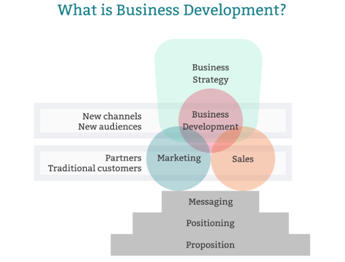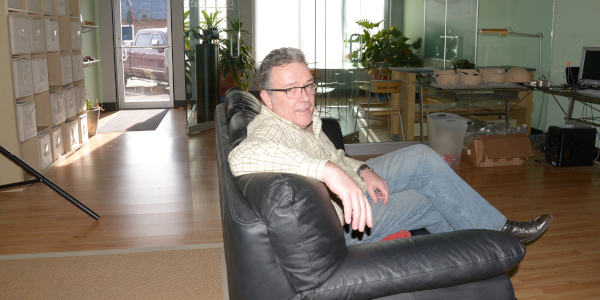Tom’s book, ‘High Frequency Change’, selfish van drivers, machines talking to machines and the future of pizza, cold calling and selling
When all about you are losing their heads, keep calm and listen to Ben. If you need clarity in new business, he’ll see you right!
Keith is a music wonk. He loves music and cannot work without it – much to the annoyance of his wife Donna, The Advertist’s Editor and his other colleagues.
There is no right or wrong time of day for him to listen to music and it runs in his family, who have all picked up various instruments at one time or another.
One of Keith’s most treasured music jobs was working and singing with the incredibly talented Peter ‘Memory’ Banks, erstwhile songwriter and ivory tickler for British 80’s pop/rock sensation After The Fire (ATF).

In the 80s Keith and Peter worked together in a band called Zipcodes with the much loved and still missed ATF drummer Pete King. Peter engineered and produced a few of Keith’s many other recordings and in the early 2000s, Peter asked Keith to take on vocal duties for the newly revived ATF as part of their comeback tour.

So it naturally fell to Peter to write and produce the theme tune for The Fuel Podcast, which Peter wrote and produced while also campaigning as an MP for the Green Party in his constituency of Mersea Island, Essex .
It’s called The Hustl (which was going to be the original name for the podcast) and you can listen to in full here:
We hope you like the music. It’s an earworm for sure and if you get a chance, please drop Peter a note of support via his Twitter feed.
What is Business Development?
Business Development. It’s a job description that appears to have multiple definitions.
Back in the 70s and 80s even into the 90s, a sales job title conjured up images of smooth-talking jack-the-lads who could charm people into buying things they didn’t want; those who “had the gift of the gab”.
In the last decade, UK sales positions have been rebranded to make them more palatable to the more sensitive souls in the business world.
A quick peruse of LinkedIn’s job board will reveal some interesting non-sales-sounding sales positions.
The Business Development job title is often used as a synonym for sales but the role of business development can sometimes have a perplexing number of applications. Business development is a skill that blends creativity, new business sales, client development, brand marketing and account management. The weighting of each discipline can vary, depending on a number of factors, an obvious one being whether it is a board level or middle management-level responsibility

The responsibilities of the role encompass new and existing business. In general, business development executives have the ability to create new outreach strategies and ideas, and execute on them. At the same time they can work with a company’s existing client base’s marketing team to recommend and implement successful new strategies and plans to help develop brands and increase the individual worth of each client to the agency.
A business development director will tend to have a lot more responsibility for the direction of a new business campaign and plans for client strategies, while business development managers tend to look after the implementation and execution of them. Referring to the diagram, the ‘Business Development’ circle can move vertically and horizontally within an organization, depending on the strategy.
This is why many companies prefer to outsource the role to business development agencies and consultants. Finding people with the right mix of talents can be time-consuming, costly and – let’s be honest here – there isn’t always a permanent need for it; like accountants or managing directors because it’s not always a fixed, definitive job description. So the role is often an interim or semi-permanent position. Business development agencies have the ability to work at the board strategic level or at the coal-face, implementing and executing strategies that have already been agreed upon.
Where many companies fall short in the outsourcing route is by not taking the counsel of these seasoned business developers. Bringing them in at the very start of the process allows them to guide the plan, make recommendations and suggest ideas that they believe are achievable.
A good business development agency or consultant will insist upon a consultation and ‘warming up’ process before the strategy launches. This time is best used laying out plans, agreeing milestones and making sure that all the required resources are ready. Therefore, the marketing and brand teams need sufficient heads up, as well as the sales and leadership teams. If client development is included in the brief, then introductions will need to be made, to avoid confusion.
Once the blueprint is agreed, it is simply a case of letting the business developer loose and carefully managing the roll-out of the plan.
From this, we can see that the role of business development can encompass many different skills and influence multiple departments of a company. It is a highly creative role (from a business knowledge perspective) and it can also require fundamental sales techniques. Above all, whether it is an in-house role or outsourced, a good business developer can become an integral synapse between important nerves of your organization, allowing insight and intelligence to feed and help grow your company.
Well, we’re getting there. We’ve managed to press-gang a few industry celebs to come aboard and offer their wisdom. But before that, here’s a preview of what you can expect.
Don’t forget to sign up and subscribe wherever you get get your podcasts.
Podcast: Play in new window | Download (Duration: 1:23 — 1.9MB)
Subscribe: Google Podcasts | Spotify | Amazon Music | Android | Pandora | Stitcher
More blood, sweat and tears than your average Baptist revival but we made it! We wanted to create something different from the usual hour-long blah-fest podcast that pervades the industry. The Fuel Podcast is something a little bit different, created by a team of people that actually know what it’s like to be on the sharp end of new business sales day in, day out. If you hit ‘subscribe’ to our podcast, we’ll keep you updated with loads of nifty interviews, tips and tales from qualified practitioners of the science that is new business. Fuel will pull on the experience of leaders of companies in a variety of sectors, highlighting how they go about drumming up new business and generating revenue. No lofty bon-mots that you can find on the first page on any Google search. No siree. Fuel gets at the coal-face of industry to deliver useful and practical advice to help you make it rain.
So why?
The Fuel Podcast is a product of years of work behind the scenes of direct sales platform The Advertist. Born from adversity, The Advertist has shrugged off attacks from much bigger entities to become a truly independent and vibrant source of new business insight, data, news People Moves and daily ammunition for anyone working in the field of new business prospecting for public relations, creative, digital, advertising marketing and social agencies. The Advertist supplies reliable information that gets you to the door of the UK’s leading and hot challenger brands and companies across 24 sectors. Frankly speaking, no-one does it better. We consistently punch above our weight because we deliver.
In describing The Advertist, we use the phrase “highly regarded” because there isn’t an award for “Best New Business Development Platform” but if there was, we’d win it.
- Best in service
- Best in price
- Best in quality
Take a free trial and see for yourself. We offer a clear and unambiguous pricing structure that makes it easy to build The Advertist into your new business activity.
Email us at hello@theadvertist.com for more information.
When people are asked to describe what elements are needed to set up a company, the answers often tend to come in boxes – a leadership box, a finance box, a manufacturing box and a selling box.
However, in today’s multichannel world, traditional methods of operating a company and marketing and selling its products have changed. The very definition of each department has altered beyond what people in the mid 20th century would have thought of as normal.
The UK public relations industry has always nervously eyed the role of sales in its organizational structure because, well, we should walk the talk. We should attract new business by doing what we do best, which is raising our brand and our profile through the subtle art of media management and influence.
But if all of your competitors are also doing this, how do you become “different”? How do you stand out?
Phil Lewis runs a management consultancy called Corporate Punk. Every day, he meets expert leaders seeking to plow a different furrow. Looking for new ways to shape their business and improve its position through a clever retooling of the company collective mindset.
I asked Phil whether it was possible to create a culture of selling across an entire organization, tailored for the 21st Century. How does he help companies take a different view of their commercial ecosystem and help them to make the best of it and have his entire team on board?
Years ago, when we first met, you were looking after strategy for an advertising agency. Even then, your focus on the intent and purpose of any campaign was refreshingly different. How does this approach parlay into the bigger picture of management consultancy and what is Corporate Punk’s ‘special sauce’?
“I’m not sure we could have developed our approach without our collective creative industry experience. Watching agencies succeeding and failing to bring the creative and innovative best out of their people over many years was the inspiration behind Corporate Punk.
“Traditional management consultants interpret people as figures in a spreadsheet. Rational units who work in uniform ways. Robots needing a tune-up! That was fine in the 20th century, where success was driven by efficiency – by optimising performance on the factory floor. But these days success is driven by increasing revenues not decreasing costs, and by competing on differentiators other than price. That means that the humanity and creativity of people is most business’s biggest asset. Most management consultancies have no idea how to maximise this. We do.”
How does a company maximize its potential to attract new business and grow in an increasingly noisy cluttered marketplace?
“You have to be unafraid to be radically different. That doesn’t mean looking different, it means behaving differently to everyone else. The world does not need another mediocre creative industry or consulting business.
“Take your convictions to their end point: explore them, state them firmly, and build what you do around them. Most businesses lack the courage to do this. In turn, they end up missing their mark. People think that it’s brave to be different. I’d argue it’s braver to be bland: your survival chances are lower.”
What do you think has been the biggest millstone for companies that traditionally rely on their sales people to be its only selling tool?
“Businesses only have two functions; to make things and to sell things. These are company-wide responsibilities: if you are not doing or supporting one or the other (occasionally both), you are not really contributing. People’s failure to grasp this fundamental truth is a major millstone in my experience. Within the creative industries, a belief that selling is not critical to success – or that it’s someone else’s responsibility – has long held many businesses back.”
How does a company get all of its employees to buy in to the idea of being part of its selling culture, and what are the advantages of doing so?
“I remember hearing Alan Weiss, a famous US consultant, describing selling as ‘identifying whether we have an opportunity to contribute’. And that was a major lightbulb moment for me. I went from perceiving sales as a grubby, ‘wide boy’ style endeavour to a process that can be genuinely additive to both parties involved. Overnight, it pretty much cured me of my fear of selling.
“Businesses that have a strong and healthy sales culture are those that can mobilise most effectively to achieve new, interesting and disruptive things. Find a successful disruptor that can’t sell! No-one at Corporate Punk gets away without selling. And they wouldn’t want to. That’s how it should be.”
When employees tell you “I’m not a sales person” or “I can’t sell” how do you respond?
“Seek to understand what’s driving their fear of sales – because fear is all that’s holding them back. Fear of rejection is the most common problem. But if the sales process is about identifying opportunities to contribute, then by definition it’s two-way. A client that needs your contribution will rarely reject you if that need is clear. A client that doesn’t need your contribution is one that you should be happy to walk away from. Fear plays no part in that equation.”
Companies love to say “We’re different” but it’s often the case that they are all saying the same thing. How do you help companies to identify their unique elements and turn them into selling points?
“I think it starts with understanding what – if anything – an organisation is doing that is genuinely different. Difference can’t come from personality or promises; it is only driven by expertise and experience. In my mentoring practice I work with agencies and other creative businesses who need to uncover this. You might be surprised by the extent to which companies bury, ignore or walk away from their actual points of difference. That’s another common way that fear shows up.”
What gives you the most reward when you have completed a project?
“I only care about the answer to one question: were things better as a result of my and the team’s involvement? I don’t care how hard the journey is, if the answer’s yes, that’s reward enough for me. Corporate Punk is my attempt to cut away everything that doesn’t directly deliver that outcome. “
There is a maxim in the world of sales that goes “Always be selling”. In this commercial world of multiple, noisy routes to market, PR agencies need to create not just a point of difference in their communications, they need to create a point of difference in their mindset; the whole approach to the generation of new prospects and opportunities.
That difference comes when a company has a visible personality and – to quote another sales aphorism: “The buyer buys the seller, not the salt”.
Phil Lewis runs Corporate Punk, a management consultancy… that isn’t. Because it doesn’t slash for efficiency. It helps clients build for innovation, resilience, growth. Instilling agility, embedding better, happier ways of working. You can contact him on 07972 143966 or by email.
Back in the 90’s, I worked for a very famous advertising agency owner who told me a story about his work on the Mercedes Benz account.
His agency used to use a market researcher, who used to kick off his meetings with “So what do you want to prove?”
This story was nearly as popular as the one about my boss storming into the office of a client that owed him money and planting a fire axe through his desk with a note pinned to it that read “Where’s my fucking money?”
The first story was a great illustration of the perils of relying on data. You don’t have to look very hard or far to find data to support any theory you want. Actually so is the second one, but more of that later.
Anyone who relies purely on data to drive sales, ends up with digital ads selling light fixtures to people that have just bought light fixtures. It’s an algorithm of the crudest data.
As someone with a keen interest in the sales process, I can absolutely confirm that data only gets you 80% of the way to closing a deal. It gives you the who? what? when? and where? but never the why?
The why? is the creative bit. It’s the bit that opens the door. It’s the bit that closes the sale, it’s the bit that makes you immediately drop what you are doing and go straight to a company’s web site to order.
Name me a hit song that has been composed on data. Name me an Oscar-winning movie directed with data. Data is cold. Creative is the thing that triggers your emotions. This is why we will never completely replace humans with cyborgs, because cyborgs don’t know how to push our emotional buttons. CMOs do.
A good CMO or a good sales person will use data to get them into position and then, at the right time deploy the creative to seal the deal.
A great sale begins with great targeting; the right person, with the right product at the right time in the right place. But it is always quickly followed by superb empathy and emotional triggers. A trigger could be fear of missing out, or how good someone will look driving a particular car, or how much younger a person would look using this make-up. Or in the case of my former boss, a trigger could be a fire axe through a desk that follows months of finely targeted letters and invoices.
The actor Edward Norton summed it up beautifully recently, talking about his movie ‘Motherless in Brooklyn’: “What audiences want is an experience, where they enter into a thing that feels authentic on its own terms. They want characters they can connect with and get carried through worlds that take them away. People get hung up on the wrong metrics. I don’t think audiences think about [a film’s] length or comprehension.” He’s right. If a film – or a piece of music for that matter – is powerful enough and drives our emotions, then we’ll go with it and attach all sorts of emotions to it.
And this is what I believe the art of being a good CMO or even a great sales person; emotion. Data cannot tell you what I’m feeling or why I might be tempted to buy your product. Data might have told you where I am, who I am, what I might want and when I might want it but only creativity will provide my emotions with a reason to take the next step. The why?
The reason we have data is not so that we can dispense with creativity. It’s not a binary choice, ironically. It can be a lovely blend of data and creativity. Techniques honed on both ends of the proposition – beautifully targeted and the right message with the right trigger.
Please don’t ever be afraid of being creative. It’s the personality behind your brand. If you rely wholly on data to do your marketing, you find the personality behind the brand is Mark Zuckerberg and personally, I could think of nothing scarier than those eyes, staring unblinkingly back at me. He’s got lifeless eyes. Black eyes. Like a doll’s eyes…


